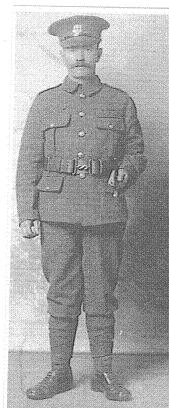|
Soldiers |
||||||||||||||||||||||||||
|
Here are details of the family members who were, or may have been, soldiers during the period up to the end of the First World War. Howcutts who were soldiers since then are not included as many of them are still living:
All the eight men
who took part in the First World War were awarded the Victory Medal and the
British Medal. Charles Herbert
Howcutt (1875-1930) Charles enlisted in the Coldstream Guards at London on 1 February 1894. He remained in the regiment for 16 years, some of the time being spent as a reservist, but never served abroad. Click here for details of what he looked like when he enlisted. Frederick Andrew
Howcutt (1884-1962) Frederick enlisted on 20 August 1914 as a private. He was a member of the 1st Brigade of the Army Service Corps, then the Lancashire Fusiliers and finally the Seaforth Highlanders. Frederick William
Howcutt (1886-1931) Frederick was a driver in the Royal Field Artillery and served in France. The date on which he qualified for the 1915 Star was 9 July 1915. George Henry Howcutt (1880-1942)
George enlisted on 3 April 1915 as a private in the Middlesex Regiment, before moving on to the Labour Corps and then to the 43rd Royal Fusiliers. His service took him to France and he was discharged to the Army Reserve on 12 March 1919. John Thomas Howcutt (1897-1972) John was a private in the Wiltshire Regiment and later in the Dorset Regiment. He was posted to France and qualified for the 1915 Star on 4 May 1915. Joseph Howcutt (baptised 1731) Click here for evidence that suggests Joseph Howcutt of Brixworth may have been a soldier in the Seven Years War. Leonard Joseph Mark
Howcutt (1892-1941) Leonard was a private in the Wiltshire Regiment and served in the Balkans. He qualified for the 1915 Star on 30 June 1915. Mark Howcutt
(1880-1965)
Mark enlisted on 31
May 1915. He was a Driver in the Royal Field Artillery and served in France.
The photograph was taken about 1917. Oliver Howcutt
(1866-1938) Oliver
enlisted in the Royal Artillery at Lincoln on 22 September 1892. He failed
his medical and was discharged four days later. Click
here for details of what he looked like at the time. William Howcutt
(1792-1878) William
enlisted in the 23rd Regiment of Dragoon/Lancers on 5 August 1808.
He was promoted from private to corporal on 25 December 1811 and again to
sergeant on 27 October 1813. He took part in the Battle of Waterloo in 1815 and
was discharged from the Army on 24 November 1817. William was granted an Army
pension in 1867 on grounds of hardship and was described as an out-pensioner
of Chelsea Hospital at the time of his death on 23 February 1878. Click here for details of what William looked like
when he enlisted. William Howcutt
(1860-1892) William
enlisted in the 4th Regiment of Foot at Westminster on 21 March
1878. His army career included 111 days at Gibraltar (1878-9), over three
years in Jamaica (1879-82) and six years in the East Indies (1884-90). He was
discharged from the Army on 10 April 1890. Click
here for details of what he looked like when he enlisted. William Howcutt
(1878-1936) William was in South Africa at the time of the Boer War, not as a soldier but in service. This presumably explains his absence from the 1901 census index. He was a corporal in the Army Service Corps during the First World War and drove an ambulance. William Henry
Howcutt (1896-1917) William enlisted at Devizes, Wiltshire as a private in the Somerset Light Infantry. He was a member of “C” company, in the 8th battalion of that regiment when he was killed, apparently at Passendale, on 4 October 1917. His grave was one of the many that could not be found after the war was over but he is commemorated on the Tyne Cot Memorial, Zonnebeke, Belgium and also at the gateway of Enford church, Wiltshire.
|

